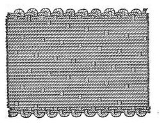
Satin weave
Encyclopedia

Textile
A textile or cloth is a flexible woven material consisting of a network of natural or artificial fibres often referred to as thread or yarn. Yarn is produced by spinning raw fibres of wool, flax, cotton, or other material to produce long strands...
weaves
Weaving
Weaving is a method of fabric production in which two distinct sets of yarns or threads are interlaced at right angles to form a fabric or cloth. The other methods are knitting, lace making and felting. The longitudinal threads are called the warp and the lateral threads are the weft or filling...
. (The other two are plain
Plain weave
Plain weave is the most basic of three fundamental types of textile weaves . It is strong and hard-wearing, used for fashion and furnishing fabrics....
and twill
Twill
Twill is a type of textile weave with a pattern of diagonal parallel ribs . This is done by passing the weft thread over one or more warp threads and then under two or more warp threads and so on, with a "step" or offset between rows to create the characteristic diagonal pattern. Because of this...
weave.) The satin weave is distinguished by its lustrous, or 'silky', appearance. Satin
Satin
Satin is a weave that typically has a glossy surface and a dull back. It is a warp-dominated weaving technique that forms a minimum number of interlacings in a fabric. If a fabric is formed with a satin weave using filament fibres such as silk, nylon, or polyester, the corresponding fabric is...
describes the way the threads are combined, and the yarn used may be silk or polyester, among others, giving different fabrics.
The satin weave is characterized by four or more cool fill or weft
Weft
In weaving, weft or woof is the yarn which is drawn through the warp yarns to create cloth. In North America, it is sometimes referred to as the "fill" or the "filling yarn"....
yarns floating over a warp
Warp (weaving)
In weaving cloth, the warp is the set of lengthwise yarns that are held in tension on a frame or loom. The yarn that is inserted over-and-under the warp threads is called the weft, woof, or filler. Each individual warp thread in a fabric is called a warp end or end. Warp means "that which is thrown...
yarn or vice versa, four warp yarns floating over a single weft yarn. This explains the even sheen, as unlike in other weaves, the light reflecting is not scattered as much by the fibres, which have fewer tucks.

